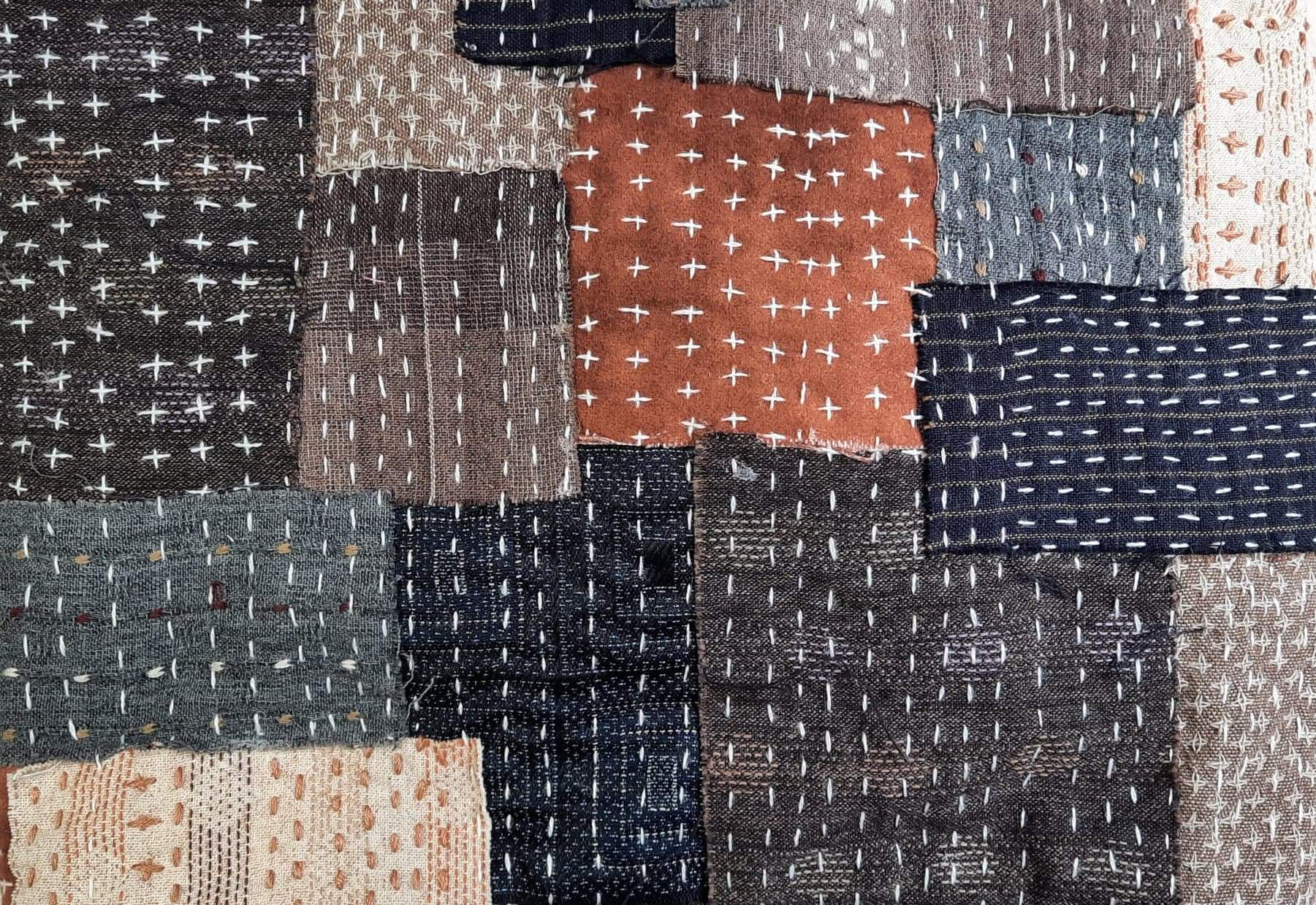
Boro Zippi purse sashiko stitching; BeBeBold. Sashiko
Quiltmaker and fabric designer Cory's (Mastering Quilt Marking) pocket guide packs an extensive amount of information into its pages without being overwhelming.Readers will learn a little history behind both traditional and modern Japanese sashiko (a functional embroidery technique that uses available resources) and boro styles (the result of that stitching).

Difference Sashiko and Boro Sashiko Story Vol 2 Upcycle Stitches
Be playful and remember there is no such thing as making a mistake. If your thread is too thick try dividing it into two separate strands. Consider different textures of fabrics and threads. Consider different lengths and directions of threads. Think about how you can use stitch-free space as well to balance out a design.

Boro Stitching Needles & Threads
While some antique pieces include simple Sashiko, boro is not a style of Sashiko stitching. It is the embodiment of another currently popular Japanese term, mottainai "don't waste!" . The vintage boro is particular easy to do, it's a factor that people want to learn themselves and practice their self and so creating particularly former .

Boro Inspired Sashiko Patchwork May 3rd Upcycle Stitches
Hitomezashi may use sashiko thread, or the slightly heavier kogin sashiko thread for stitching in order to increase the 'plump grain of rice' effect of the stitches. Kogin (photo below) stitching is also a type of sashiko. Again it is stitched with the heavier kogin sashiko cotton thread to increase the 'fat rice grain' effect of each stitch.

Boro Inspired Patch With Sashiko Stitching Denim and Cotton Etsy
Japanese Boro Stitching is a traditional art form that embraces upcycling and repurposing. Its simple stitches bring function and beauty to the garment. Each textile tells a story — whether it is the scraps of fabrics that are used for the patches, or the stitches chosen for the repair. Mending brings fashion and interest to the item.

Japanese Boro Sashiko Slow Stitch mending patch Natural Indigo Full
The Shibaguyz share their love of boro & sashiko and about their brand new book, Boro & Sashiko, Harmonious ImperfectionAbout the book:30+ authentic stitch p.

Japanese boro SashikoSlow stitch PatchHand sewn of recycled fabrics
However. Boro is not a word for patchworking. Boro is not a technique of mending. Boro represents the poverty in Japan, Shame and Pride. Boro isn't just about "worn" fabric. Boro carries a lot of stories, and the Japanese Culture. We are here to share. We make "To-Be-Authentic Boro" today to respect the Japanese.

Japanese boro and sashiko inspired hand stitching embroidery art
The effect of "loving" someone, including ourselves, is referred to as boro. Sashiko is a form of embroidery that uses white-on-indigo threadwork, while boro refers to the use of rags or tattered cloth. Sashiko stitching was born sometime in the Edo period (1615-1868) and was often used to repair and repurpose fabrics.

Japanese Boro Sashiko slow stitch mending patch naturally hand dyed
While some practitioners take a freeform approach, the most pleasing stitches tend to be in the sashiko tradition.. Sashiko—frequently translated as "little stabs"—was born in Edo period Japan (1603-1868), when rural women attempted to prolong the life of their families' tattered garments and bedding, giving rise to a humble.

Difference Sashiko and Boro Sashiko Story Vol 2 Upcycle Stitches
Sashiko tends to come hand in hand with boro as it was one of the more reliable stitching techniques used for patching. For more in-depth insights on sashiko, check out 7 Things to Know About Japanese Embroidery. Shonai Boro. This type of boro finds its roots in the picturesque Shonai region of Yamagata Prefecture.

hand stitched sashiko and Japanese boro inspired fiber art Japanese
Sashiko means "little stabs", made via needle and thread into cloth. These little stabs are used to decorate or repair the cloth involved. It is traditionally used to strengthen the cloth. Basic Japanese mending developed by one of Ailish Henderson's students. There are other names given to Sashiko and Boro, which are more general in form.
sashiko and other stitching Edinburgh Exploring Japanese Boro
Boro is Japanese for 'rag'. Sashiko is the simple running stitch that holds the boro in place. As all things Japanese, words convey a more complex background. Style of the past. During the Edo period, it was a frugal time so every scrap of fabric was put to good use. The stitching was a way of strengthening and attaching the fabric to an.

Pin by Susie on Boro Textile art, Patchwork art, Sashiko embroidery
My understanding is. Sashiko is a form of stitching, a process of needlework. The Boro is the result of continuous & ultimate repetition of Sashiko. In other words, Sashiko can be a verb in Japanese. We occasionally say that we "do Sashiko". In contrast, Boro doesn't become a verb in the Japanese language.

Boro stitching image by Tim on sashiko boro Sashiko, Upcycle clothes
By Mary Ray Threads #195, Feb./March 2018. The Japanese art of mending, called boro, is experiencing a resurgence. Originally, the quilting technique was applied to extend the life of ragged and tattered clothes and household items by sewing patches in place with sashiko, a simple running stitch. Typically sewn in a pattern of parallel lines.

Boro & Sashiko, Harmonious Imperfection The Art of Japanese Mending
Boro is a ultimate result of repetitive Sashiko stitchings over and over for many generations. The Japanese had to use the fabric even it gets tattered beyond the normal usage. They patched the fabric and stitched to make the fabric usable. Boro is merely a result of continuous stitching.

Boro and Sashiko Harmonious Imperfection {book review} the
Boro textiles are restored by overlapping and stitching spare or discharged scraps of fabric together, essentially using a sashiko stitch, to reinforce the material. Boro fabrics were typically indigo-dyed as it was the cheapest natural dye available, and a remarkable number of boro pieces also showcase kasuri dye work, a form of ikat dyeing.